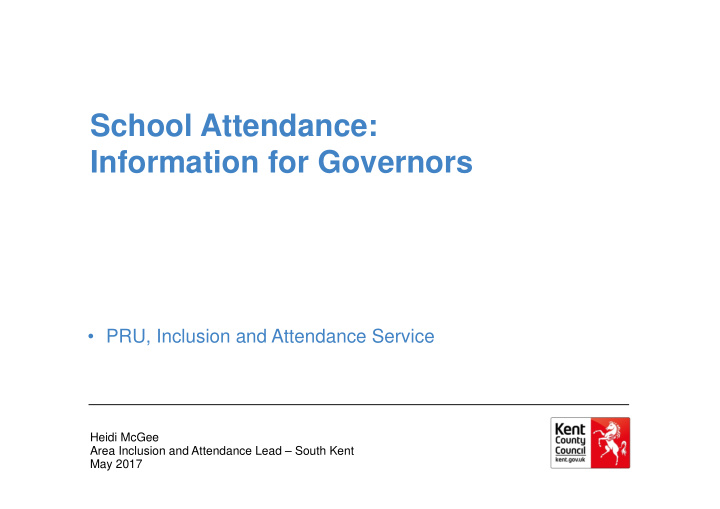



School Attendance: Information for Governors • PRU, Inclusion and Attendance Service Heidi McGee Area Inclusion and Attendance Lead – South Kent May 2017
School Attendance • 2015/16 attendance in Kent improved from 4.9% to 4.7% but was below the national average which remained at the same rate (4.6%) • The most common reason for absence was illness - 57.3% • Absence due to family holiday increased from 7.5% to 8.2%
Early Help and Preventative Services • PRU, Inclusion and Attendance Service is part of Early Help and Preventative Services • In many cases the root causes of poor attendance are family and social issues • PIAS – support for schools, prosecutions and PNs • Every school has a named School Liaison Officer
School Liaison Officers • Advice, support and training on procedures, strategies and projects • Attendance Officer Network Meetings • Register Audits • Casework and preparation of cases for prosecution
Legal Responsibility of Parents • The Education Act 1996 states: ‘If any child of compulsory school age, who is a registered pupil at a school, fails to attend regularly at the school, his parent is guilty of an offence.’ • The responsibility to ensure regular school attendance rests solely with the parent(s). Failure to ensure regular school attendance is a criminal offence.
Legal Responsibilities of Schools • The Education (Pupil Registration) (England) Regulations 2006 • Removal from roll • Marking of registers – DfE guidance Nov 2016 • Section 434(6) Education Act 1996
Promoting good attendance • Whole School Ethos • School Attendance Policy • Home/School Agreement • Activities in school • Individualised support
Persistent Absence • The government now classes any pupil with attendance below 90% as a ‘persistent absentee’ • Schools report their PA Rate to the DfE • Schools should have systems in place to track PA pupils and prevent pupils becoming PA • 90% - perception of parents 00/00/2013 Your Name
Tackling Poor Attendance • Close monitoring – cohorts and individuals • School Action • Referral for Early Help support • Referral to PIAS for prosecution - key referral criterion - below 90% attendance with a minimum of 10 days’ unauthorised absence
Referral Criteria – School Action • Contact with parents • Offer of appropriate support to both parents and pupil including Early Help Notification • Known medical issues investigated and advice sought - eg School Nursing Service. • Parents must be made aware that absence is not authorised - the decision to authorise absence rests solely with the Headteacher.
Penalty Notices • Schools can use PNs if this is included in the school’s Attendance Policy and has been widely and regularly publicised • Revised Code of Conduct April 2017 • A PN can be issued instead of prosecuting the parent in the Magistrates’ Court. • A PN can be issued for poor attendance (including persistent late arrival), holidays in term-time and where an excluded child is found in a public place during school hours
Children Missing Education • A child of compulsory school age who is not on roll of a school and is not receiving suitable education otherwise • When the whereabouts of children are unknown and the school has made every effort to find them
Children Missing Education – a school’s duty to report • Children Missing Education via DFD eg: o A child has moved out of the area but the Common Transfer File has not been requested by another school o A child has emigrated • Removal from roll via DFD
Questions to ask • Is the School Attendance Policy up to date and in line with latest DfE guidance and KCC Code of Conduct? • Is there effective communication with parents? • How is good attendance promoted and poor attendance addressed? • Are sufficient time/resources given to attendance?
Sources of Information • KELSI – www.kelsi.org.uk/pru-inclusion-and-attendance-service-pias • Attendance Officer Network Meetings • Named School Liaison Officer • Heidi McGee 03000 418689 catherine.edwards@kent.gov.uk
Recommend
More recommend